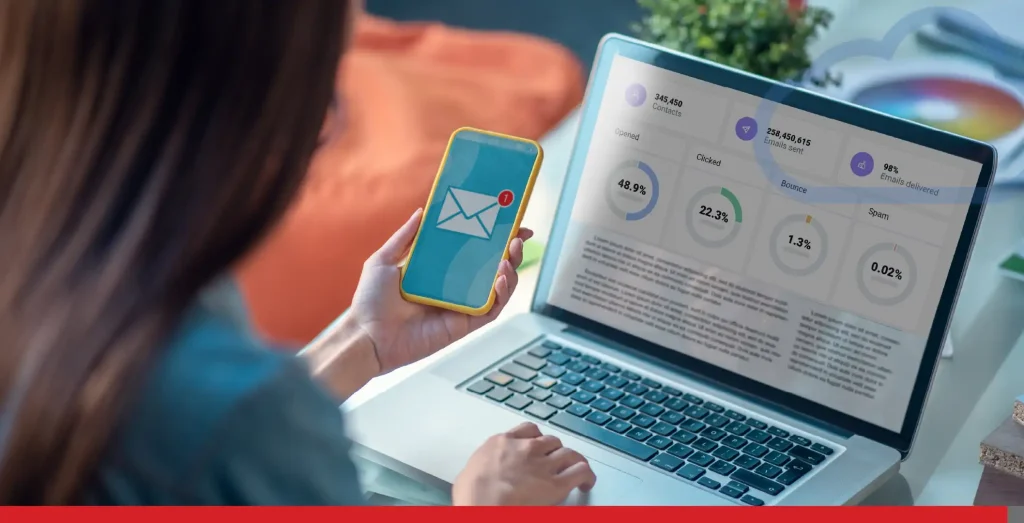We’re sure you’ve heard the term email marketing before. Email marketing remains one of the most powerful tools to help businesses maintain an engaged audience.
Consider this: 50% of B2C consumers and a staggering 77% of B2B buyers prefer email communication for updates and promotions. Not only does email offer direct engagement, but its return on investment (ROI) is unparalleled—delivering an average of $42 for every $1 spent.
With the evolution of technology, email marketing has transformed, offering opportunities for personalization, interactivity, and automation.
The winning recipe is all about creating customized experiences that guide recipients throughout their shopping journey. Whether it’s sparking initial interest, nurturing leads, or closing sales, email marketing remains integral to every stage of the shopping journey.
In this guide, we’ll examine proven strategies and applicable tips for crafting engaging email campaigns that capture attention and drive conversions.
- 1. Start with a Clear Plan: What’s Your Goal?
- 2. Preparing Engaging Email Campaigns
- 3. Writing High-Quality Email Copy & Subject Lines
- 4. Using Email Builder Tools
- 5. Optimize for Conversions: Are Your CTAs Compelling?
- 6. Responsive Email Design
- 7. Measuring Email Marketing Success

1. Start with a Clear Plan: What’s Your Goal?
Every successful email marketing campaign begins with clear planning and goal setting. Without a defined purpose, even the most well-designed email can fail to deliver meaningful results.
The foundation of a productive campaign is knowing what you aim to achieve. Are you looking to:
- Drive traffic to your site?
- Increase brand awareness?
- Convert leads into loyal customers?
By determining your objectives, you can shape your strategy, tailor your messaging, and set measurable targets.
Incorporating strategic calls to action in your emails can foster urgency and motivate potential customers to take action, helping you achieve your campaign goals.
You can also use insights from analytics or CRM tools to understand your audience’s preferences and behaviours.
Know Your Audience: Why Did They Subscribe?
Your audience’s preferences and behaviours should guide your planning. Segment your email list based on demographics, purchase history, or engagement levels.
Tools like CRM software or analytics platforms can provide valuable insights to refine your targeting.
When Should You Send Emails?
Timing matters in email marketing. Map out your email sequence to align it with the buyer’s journey:
- For new leads, introduce your brand and highlight principal offerings.
- For potential buyers, send emails that address pain points and present solutions.
- For returning customers, share exclusive offers or loyalty rewards.
Tailoring the length and frequency of your email sequences ensures relevance at every stage, increasing the likelihood of conversions.
With a clear plan, you’re set to craft emails that resonate, engage, and drive results. Up next, we’ll dive into how to create campaigns that truly capture attention.
2. Preparing Engaging Email Campaigns
What makes an email stand out in a crowded inbox? The answer lies in understanding your audience and delivering content that feels tailored to their needs.
Companies that leverage personalization and other strategies in their email marketing can seriously increase customer attention and achieve better financial results.
Who Are You Talking To?
Your subscribers signed up for a reason—what is it? Are they looking for industry insights, exclusive deals, or updates on your products?
Knowing their motivations is the prime factor in crafting emails that resonate. By targeting different segments of your contact database based on these criteria, you can tailor your messages to meet their specific needs and preferences better.
The Magic of Personalization
Did you know that personalized emails increase open rates by 26%? Simple touches like using the recipient’s name or tailoring product recommendations can make a world of difference.
Segment your audience into smaller groups based on behaviour, demographics, or interests to ensure your emails hit the mark.
Think of When to Hit Send
When should you send your emails? We touched on that in our previous section, but it’s worth noting here as well. Timing is everything. Experiment with different days and times to discover when your audience is most likely to engage.
For instance, B2B audiences often respond better to emails sent during weekday mornings, while B2C consumers may prefer evenings or weekends since that’s the time they’re off work.
While hitting send and making your email campaigns live is an all-important step, siding with a dependable web host for your business is also decisive.
EasyHosting ensures you get top-notch web hosting, domain name, plus email and digital marketing services right at your fingertips. Interested?
You can visit us at www.easyhosting.com, send an email at support@easyhosting.com or even call us at 1-888-390-1210!

3. Writing High-Quality Email Copy & Subject Lines
How do you grab attention in just a few seconds? Email marketing campaigns hold the secret to engaging prospects and customers. Start with the subject line, which is the first thing (and sometimes the only thing) people read in your communications.
What’s in a Subject Line?
The summary of your offer. The subject line is your first (and sometimes only) chance to entice readers. Keep it short, clear, and intriguing.
Some examples:
- Don’t Miss Out: Exclusive Offers Inside
- Your Free Guide Awaits!
Does Your Copy Speak Their Language?
Write as though you’re having a one-on-one conversation. Focus on the benefits your readers care about. Use action-oriented language that encourages them to take the next step. For example:
- Instead of “We offer free shipping,” try “Get your favourite items delivered for free!”
Design Emails That Stand Out
Visual appeal matters—especially in a crowded inbox.
- Use clean layouts and mobile-friendly designs (many emails are opened on mobiles).
- Incorporate compelling images and clear CTAs.
- Opt for a single-column layout for easy scrolling.
4. Using Email Builder Tools
You don’t need to be a designer to create professional emails, but you do need to have the right tools to do so.
- Use drag-and-drop email builders to craft polished, personalized emails quickly.
- Take advantage of automation features to streamline workflows and scale up your campaigns.
Try some of the best email marketing software to ensure you’re making the best choice for your business and target industry.
Have You Used Segmentation?
A successful campaign starts with a high-quality email list. Use a double opt-in process to ensure subscribers genuinely want to hear from you. This reduces spam complaints and increases engagement rates.
Be Ready to Scale
With automation features, email builder tools let you personalize messages at scale, saving time while improving the customer experience.

5. Optimize for Conversions: Are Your CTAs Compelling?
How do you turn readers into customers? Perfection is the answer.
Your call-to-action (CTA) is the star of your email. It should stand out and compel readers to act. Use action verbs like Shop Now, Download, or Get Started to create urgency and excitement.
Is Your Content Personalized?
Every recipient is unique, and your emails should reflect that. Personalized content and tailored timing can significantly boost conversions. For example, to recapture potential sales, send abandoned cart emails within a few hours.
What Is a Good Conversion Rate for Email Campaigns?
When evaluating the success of your email marketing efforts, one metric stands out: the email marketing conversion rate.
This rate is an important metric for measuring campaign success. It analyzes the percentage of subscribers who complete a call-to-action after reading an email.
But what qualifies as good?
Benchmarking Conversion Rates
In general, a good conversion rate for email marketing is anything above 10%, with top-performing businesses achieving rates of between 11—12%. This puts your campaign in the upper echelon of global marketers, showcasing how successful your strategy is.
Why Aim for 10% & Up?
Reaching or exceeding this benchmark indicates that your email campaigns are resonating with your audience. It means your subject lines, content, and CTAs are compelling enough to drive action—whether that’s making a purchase, signing up for a webinar, or downloading a resource.
Boosting Your Conversion Rates
If your current rates are falling short, don’t worry—there are plenty of ways to turn that around:
- Offer incentives: A discount code, free shipping, or exclusive access can nudge subscribers toward taking action.
- Focus on personalization: Tailor your emails to individual preferences, making them feel more relevant and valuable.
- Simplify the CTA: Ensure your call-to-action is clear, prominent, and easy to follow.
A great example of effective email marketing is how some companies use animation in their emails to expand engagement. You might also consider how well-segmented promotional efforts can substantially boost marketing revenue.
By combining these tactics with continuous testing and refinement, you can push your campaigns into the top-performing category and achieve conversion rates that deliver tangible business results.
6. Responsive Email Design
Why is a mobile revamp critical? Because it’s estimated that nearly 50 to 60% of all emails are opened on mobile devices!
What Makes a Mobile-Friendly Email?
- Use a single-column layout for easy scrolling.
- Adjust images to load quickly on slower connections.
- Ensure buttons and links are large enough to tap effortlessly.
Less Can Be More
Did you know that sending fewer, more valuable emails can drive better results? Re-engaging inactive subscribers with valuable content is crucial to maintaining a healthy email list. When your emails consistently offer high-quality content, your audience will look forward to them.

7. Measuring Email Marketing Success
You can’t improve what you don’t measure. Keep an eye on these key metrics:
- Open rate: Indicates how well your subject lines perform.
- Click-through rate (CTR): This shows how engaging your content is.
- Conversion rate: Measures how many recipients completed your desired action.
By tracking and analyzing these metrics, you can refine your campaigns for even better results.
Final Words
Email marketing is one of the most powerful ways to nurture leads, engage your audience, and retain customers. By combining these 10 proven tips with continuous testing and refinement, you can create campaigns that deliver exceptional ROI.
Ready to take your email marketing to the next level? Explore tools and services from EasyHosting that can help you streamline your campaigns and boost conversions today!
You can visit us at www.easyhosting.com, send an email at support@easyhosting.com or even call us at 1-888-390-1210!
FREQUENTLY ASKED QUESTIONS
What is the 80/20 Rule in email marketing?
The 80/20 rule in email marketing refers to the idea that 80% of your email content should focus on providing value to your audience, such as educational tips, helpful resources, or engaging stories.
The remaining 20% can be promotional, encouraging recipients to take action, such as making a purchase or signing up for a service.
What is an example of an email campaign?
A classic example of an email campaign is a welcome email series for new subscribers:
- Email 1 (Day 1): Welcome the subscriber, thank them for joining, and introduce your brand. Example subject line: Welcome to [Brand Name]—Here’s What You Can Expect!
- Email 2 (Day 2): Share helpful resources or tips related to your products or services. Example: A clothing brand could send styling tips or a guide to seasonal trends.
- Email 3 (Day 5): Include a special offer to encourage a first purchase. Example: Enjoy 15% Off Your First Order—Shop Now!
Additionally, a scheduled series can be used in email marketing campaigns to engage prospects and customers. This activity encourages them to take specific actions that advance their position within the marketing funnel.
Does Gen Z engage with email marketing?
Yes, Gen Z engages with email marketing, but their preferences differ from older generations. Gen Z values personalization, visual appeal, and concise content with clear and to-the-point messaging.
What is a good conversion rate for email campaigns?
A good email conversion rate is typically around 10%, with top-performing campaigns achieving 11—12%.
How can I make my email campaigns more engaging?
Focus on personalization, compelling subject lines, and visually appealing designs.
What tools should I use for email marketing?
Consider email builder tools that offer automation, personalization, and analytics features.



